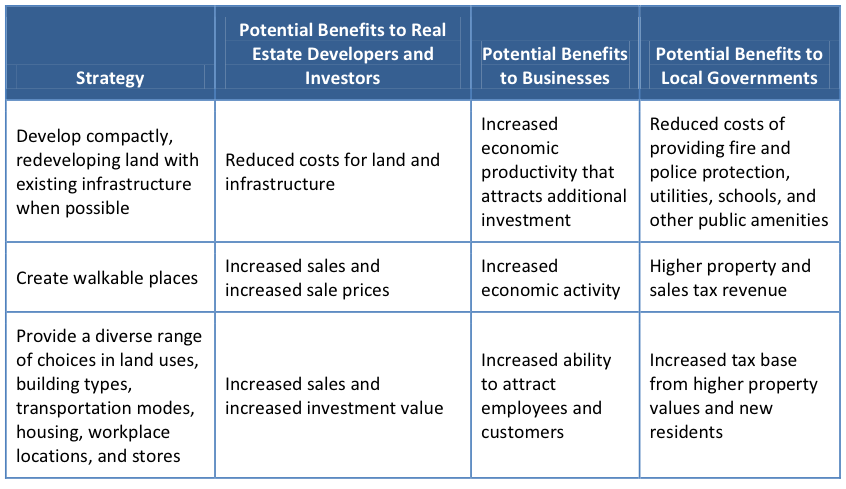ENVIRONMENTAL PROTECTION AGENCY
Executive Summary
Smart growth development is compact and walkable and provides a diverse range of choices in land uses, building types, transportation, homes, workplace locations, and stores. Such development projects are attractive to private-sector interests because they can find a ready market and compete financially. They appeal to local governments because they can be the building blocks of a growing economy and high-quality, economically sustainable neighborhoods and communities while also helping to create a cleaner, healthier environment. Some of the advantages for developers, communities, and local governments associated with smart growth include:
- Compact development: Using land and resources more efficiently and redeveloping old or neglected areas while retaining existing infrastructure can create economic advantages for real estate developers and investors, businesses, and local governments. Compact development can generate more revenue per acre because it uses land more efficiently. It can reduce the costs of land and infrastructure for individual projects and the costs of providing fire and police protection, utilities, schools, and other public amenities. By locating companies closer together, compact development can create a density of employment that increases economic productivity and attracts additional investment.
- Walkability: Walkable neighborhoods have well-connected streets and a mix of land uses near each other, making not only walking but also bicycling and transit more convenient and appealing. Projects in walkable neighborhoods command a price premium, earning real estate developers and investors a higher return on investment. Improvements to streets and sidewalks to make them more appealing to pedestrians can benefit local businesses by attracting more customers. In turn, local governments benefit through additional property and sales tax revenue.
- Range of choices: People and businesses value places that bring together a variety of activities to create vibrant environments. The demand for such places exceeds the supply. Many people in the two largest demographic cohorts, baby boomers and their children, are particularly interested in lively neighborhoods with their daily needs close by. Communities with access to transit also help people reduce their transportation costs, enabling them to save money or spend more on their homes, entertainment, or other things they value. Changing demographics will likely further increase the demand for smart growth development over the coming decades; developers, investors, businesses, and local governments who respond to these market preferences could reap economic advantages.
The following table summarizes the strategies outlined in this report that can play a key role in creating profitable real estate development, productive economic development, and economically resilient communities.
This report is the first in a series from EPA’s Smart Growth Program designed to inform developers, businesses, local government, and other groups about the benefits of smart growth development. Additional reports will build on this work, exploring how real estate developers and investors can overcome real and perceived barriers to benefit from infill opportunities, how decisions about where to locate will impact the bottom lines of businesses, and why smart growth strategies are good fiscal policy for local governments.
Read full report (PDF) here: Smart Growth and Economic Success
About the US Environmental Protection Agency (EPA)
www.epa.gov
“The mission of EPA is to protect human health and the environment. EPA’s purpose is to ensure that: all Americans are protected from significant risks to human health and the environment where they live, learn and work; national efforts to reduce environmental risk are based on the best available scientific information; federal laws protecting human health and the environment are enforced fairly and effectively…”
Tags: Environmental Protection Agency, EPA, Smart Growth and Economic Success







 RSS Feed
RSS Feed